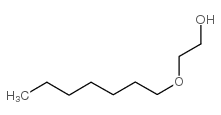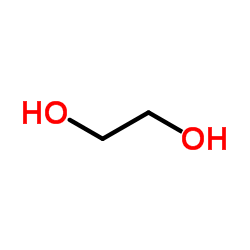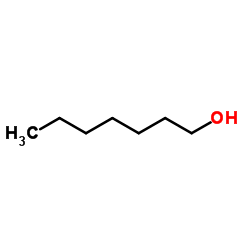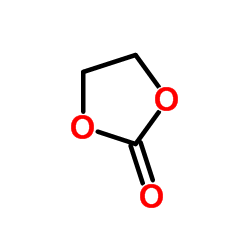7409-44-1
| 中文名 | 庚氧基乙醇 |
|---|---|
| 英文名 | 2-heptoxyethanol |
| 中文别名 | HEPTYLOXYETHANOL |
| 英文别名 |
2-Heptyloxy-aethanol
Monoheptyl ether of ethylene glycol HEPTYLOXYETHANOL EINECS 206-740-2 heptoxyethanol ethylene glycol n-heptyl ether 2-heptyloxyethan-1-ol Heptyl cellosolve 3-Oxadecanol Ethylene glycol monoheptyl ether MFCD01727884 |
| 密度 | 0.885g/cm3 |
|---|---|
| 沸点 | 224.4ºC at 760 mmHg |
| 分子式 | C9H20O2 |
| 分子量 | 160.25400 |
| 闪点 | 63.2ºC |
| 精确质量 | 160.14600 |
| PSA | 29.46000 |
| LogP | 1.96570 |
| 折射率 | 1.432 |
| 储存条件 | 密封储存,储存于阴凉、干燥的库房。 |
| 计算化学 | 1.疏水参数计算参考值(XlogP):无 2.氢键供体数量:1 3.氢键受体数量:2 4.可旋转化学键数量:8 5.互变异构体数量:无 6.拓扑分子极性表面积29.5 7.重原子数量:11 8.表面电荷:0 9.复杂度:64.6 10.同位素原子数量:0 11.确定原子立构中心数量:0 12.不确定原子立构中心数量:0 13.确定化学键立构中心数量:0 14.不确定化学键立构中心数量:0 15.共价键单元数量:1 |
| 更多 | 1. 性状:浅黄色透明液体 2. 密度(g/mL,20℃):未确定 3. 相对蒸汽密度(g/mL,空气=1):未确定 4. 熔点(ºC):未确定 5. 沸点(ºC,常压):未确定 6. 沸点(ºC,74mmHg):未确定 7. 折射率(n20/D):未确定 8. 闪点(ºC):未确定 9. 比旋光度(º):未确定 10. 自燃点或引燃温度(ºC):未确定 11. 蒸气压(mmHg,217ºC):未确定 12. 饱和蒸气压(kPa,25ºC):未确定 13. 燃烧热(KJ/mol):未确定 14. 临界温度(ºC):未确定 15. 临界压力(KPa):未确定 16. 油水(辛醇/水)分配系数的对数值:未确定 17. 爆炸上限(%,V/V):未确定 18. 爆炸下限(%,V/V):未确定 19. 溶解性:溶于水 |
Synonym:Ethyleneglycol monoheptylether Section 2 - COMPOSITION, INFORMATION ON INGREDIENTS
Risk Phrases: 36/37/38 Section 3 - HAZARDS IDENTIFICATION EMERGENCY OVERVIEW
Irritating to eyes, respiratory system and skin. Potential Health Effects Eye: Causes eye irritation. Skin: Causes skin irritation. Ingestion: May cause gastrointestinal irritation with nausea, vomiting and diarrhea. Inhalation: Causes respiratory tract irritation. Can produce delayed pulmonary edema. Chronic: Effects may be delayed. Section 4 - FIRST AID MEASURES Eyes: Immediately flush eyes with plenty of water for at least 15 minutes, occasionally lifting the upper and lower eyelids. Get medical aid. Skin: Get medical aid. Flush skin with plenty of water for at least 15 minutes while removing contaminated clothing and shoes. Wash clothing before reuse. Ingestion: Never give anything by mouth to an unconscious person. Get medical aid. Do NOT induce vomiting. If conscious and alert, rinse mouth and drink 2-4 cupfuls of milk or water. Inhalation: Remove from exposure and move to fresh air immediately. If not breathing, give artificial respiration. If breathing is difficult, give oxygen. Get medical aid. Do NOT use mouth-to-mouth resuscitation. Notes to Physician: Treat symptomatically and supportively. Section 5 - FIRE FIGHTING MEASURES General Information: As in any fire, wear a self-contained breathing apparatus in pressure-demand, MSHA/NIOSH (approved or equivalent), and full protective gear. During a fire, irritating and highly toxic gases may be generated by thermal decomposition or combustion. Vapors may be heavier than air. They can spread along the ground and collect in low or confined areas. Runoff from fire control or dilution water may cause pollution. Extinguishing Media: Use water spray to cool fire-exposed containers. Use water spray, dry chemical, carbon dioxide, or appropriate foam. Section 6 - ACCIDENTAL RELEASE MEASURES General Information: Use proper personal protective equipment as indicated in Section 8. Spills/Leaks: Absorb spill with inert material (e.g. vermiculite, sand or earth), then place in suitable container. Avoid runoff into storm sewers and ditches which lead to waterways. Clean up spills immediately, observing precautions in the Protective Equipment section. Provide ventilation. Section 7 - HANDLING and STORAGE Handling: Avoid contact with eyes, skin, and clothing. Keep container tightly closed. Avoid ingestion and inhalation. Use with adequate ventilation. Wash clothing before reuse. Storage: Store in a tightly closed container. Store in a cool, dry, well-ventilated area away from incompatible substances. Section 8 - EXPOSURE CONTROLS, PERSONAL PROTECTION Engineering Controls: Facilities storing or utilizing this material should be equipped with an eyewash facility and a safety shower. Use adequate ventilation to keep airborne concentrations low. Exposure Limits CAS# 7409-44-1: Personal Protective Equipment Eyes: Wear chemical splash goggles. Skin: Wear appropriate protective gloves to prevent skin exposure. Clothing: Wear appropriate protective clothing to prevent skin exposure. Respirators: Follow the OSHA respirator regulations found in 29 CFR 1910.134 or European Standard EN 149. Use a NIOSH/MSHA or European Standard EN 149 approved respirator if exposure limits are exceeded or if irritation or other symptoms are experienced. Section 9 - PHYSICAL AND CHEMICAL PROPERTIES Physical State: Liquid Color: slightly yellow Odor: odorless pH: Not available. Vapor Pressure: Not available. Viscosity: Not available. Boiling Point: Not available. Freezing/Melting Point: Not available. Autoignition Temperature: Not available. Flash Point: Not available. Explosion Limits, lower: Not available. Explosion Limits, upper: Not available. Decomposition Temperature: Solubility in water: Soluble. Specific Gravity/Density: Molecular Formula: C9H20O2 Molecular Weight: 160.26 Section 10 - STABILITY AND REACTIVITY Chemical Stability: Stable at room temperature in closed containers under normal storage and handling conditions. Conditions to Avoid: Excess heat. Incompatibilities with Other Materials: Strong oxidizing agents. Hazardous Decomposition Products: Carbon monoxide, irritating and toxic fumes and gases, carbon dioxide. Hazardous Polymerization: Has not been reported Section 11 - TOXICOLOGICAL INFORMATION RTECS#: CAS# 7409-44-1: KL2100000 LD50/LC50: CAS# 7409-44-1: Draize test, rabbit, eye: 100 mg Severe; Draize test, rabbit, skin: 500 mg Moderate; Oral, rat: LD50 = 2280 mg/kg. Carcinogenicity: Ethanol, 2-(heptyloxy)- - Not listed by ACGIH, IARC, or NTP. Other: See actual entry in RTECS for complete information. Section 12 - ECOLOGICAL INFORMATION Section 13 - DISPOSAL CONSIDERATIONS Dispose of in a manner consistent with federal, state, and local regulations. Section 14 - TRANSPORT INFORMATION IATA Shipping Name: Not regulated. Hazard Class: UN Number: Packing Group: IMO Shipping Name: Not regulated. Hazard Class: UN Number: Packing Group: RID/ADR Shipping Name: Not regulated. Hazard Class: UN Number: Packing group: Section 15 - REGULATORY INFORMATION European/International Regulations European Labeling in Accordance with EC Directives Hazard Symbols: XI Risk Phrases: R 36/37/38 Irritating to eyes, respiratory system and skin. Safety Phrases: S 26 In case of contact with eyes, rinse immediately with plenty of water and seek medical advice. S 37/39 Wear suitable gloves and eye/face protection. WGK (Water Danger/Protection) CAS# 7409-44-1: No information available. Canada None of the chemicals in this product are listed on the DSL/NDSL list. CAS# 7409-44-1 is not listed on Canada's Ingredient Disclosure List. US FEDERAL TSCA CAS# 7409-44-1 is not listed on the TSCA inventory. It is for research and development use only. SECTION 16 - ADDITIONAL INFORMATION N/A |
|
毒理学数据: 1、皮肤/眼睛刺激性 标准的Draize试验:兔子,皮肤接触:500mg;反应的严重程度:中度。 标准的Draize试验:兔子,眼睛接触:100mg;反应的严重程度:严重。 2、急性毒性:大鼠经口LD50:2280mg/kg; CHEMICAL IDENTIFICATION
HEALTH HAZARD DATAACUTE TOXICITY DATA
|
| 危害码 (欧洲) | Xi |
|---|---|
| 风险声明 (欧洲) | 36/37/38 |
| 安全声明 (欧洲) | S26;S37/S39 |
|
~27% 
7409-44-1 |
| 文献:Lebedeva; Mazaev; Tret'yakov Russian Journal of Applied Chemistry, 2001 , vol. 74, # 8 p. 1415 - 1417 |
|
~% 
7409-44-1 |
| 文献:Kucharski,S. et al. Roczniki Chemii, 1973 , vol. 47, p. 2045 - 2054 |
|
~% 
7409-44-1 |
| 文献:Broek, L. A. G. M. van den; Vermaas, D. J.; Kemenade, F. J. van; Tan, M. C. C. A.; Rotteveel, F. T. M.; et al. Recueil des Travaux Chimiques des Pays-Bas, 1994 , vol. 113, # 11 p. 507 - 516 |
|
~% 
7409-44-1 |
| 文献:Dupont et al. Bulletin de la Societe Chimique de France, 1955 , p. 638,641 |
|
~% 
7409-44-1 |
| 文献:Dupont et al. Bulletin de la Societe Chimique de France, 1955 , p. 638,641 |
|
~% 
7409-44-1 |
| 文献:Dupont et al. Bulletin de la Societe Chimique de France, 1955 , p. 638,641 |
|
~% 
7409-44-1 |
| 文献:Dupont et al. Bulletin de la Societe Chimique de France, 1955 , p. 638,641 |
|
~% 
7409-44-1 |
| 文献:Cooper; Partridge Journal of the Chemical Society, 1950 , p. 459,463 |
| 上游产品 7 | |
|---|---|
| 下游产品 0 | |








